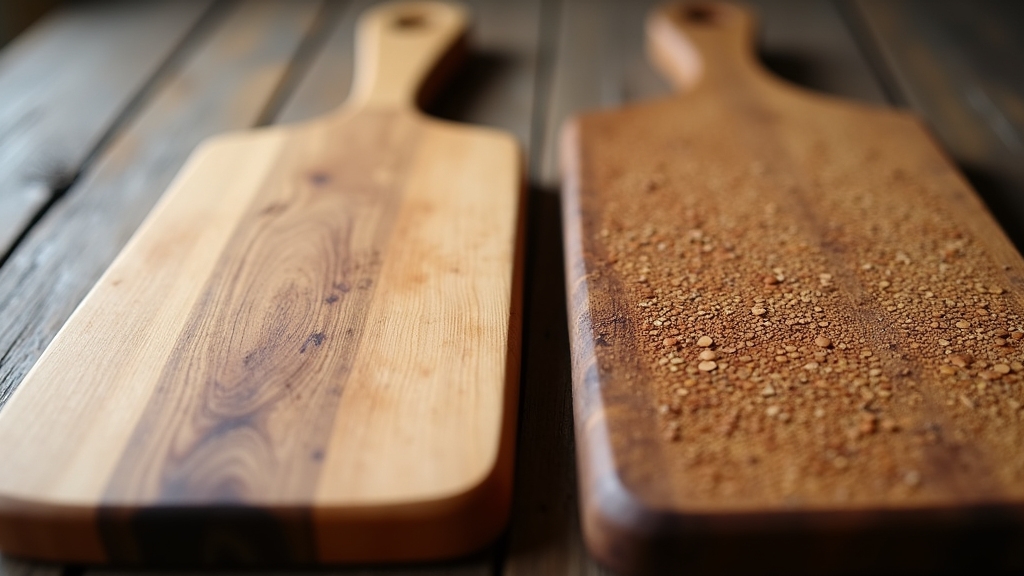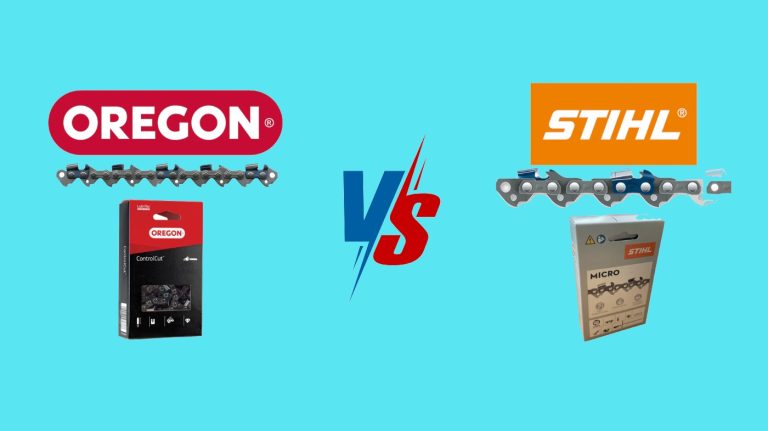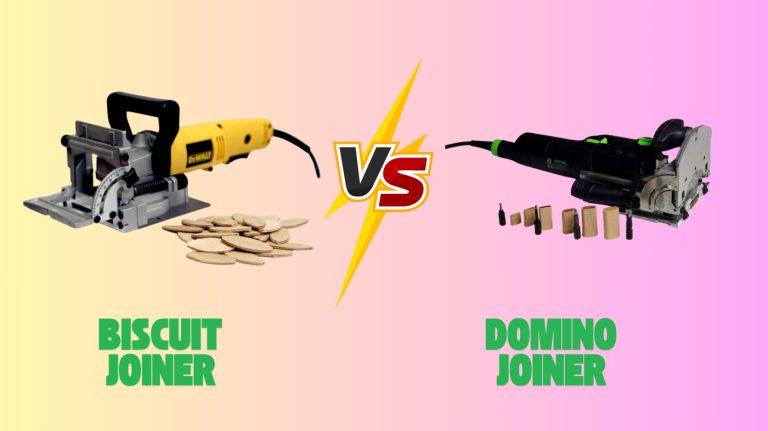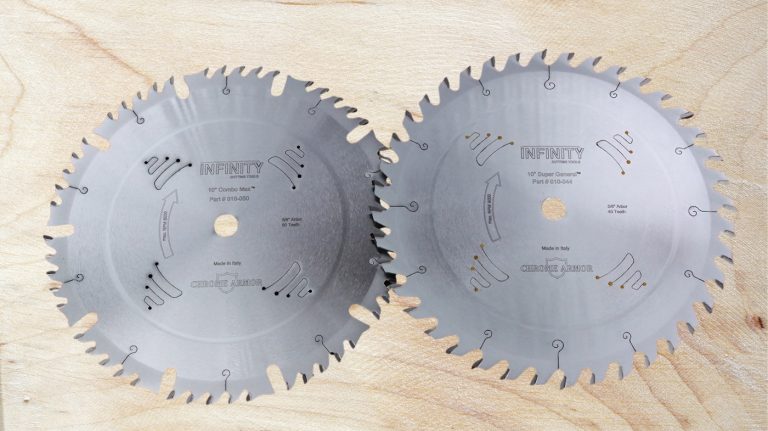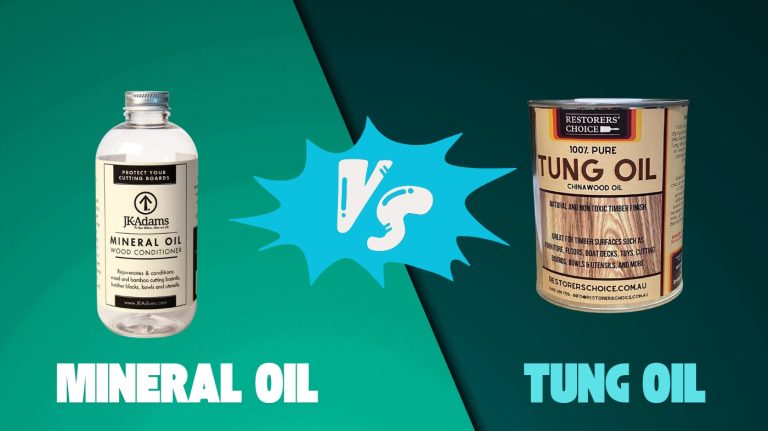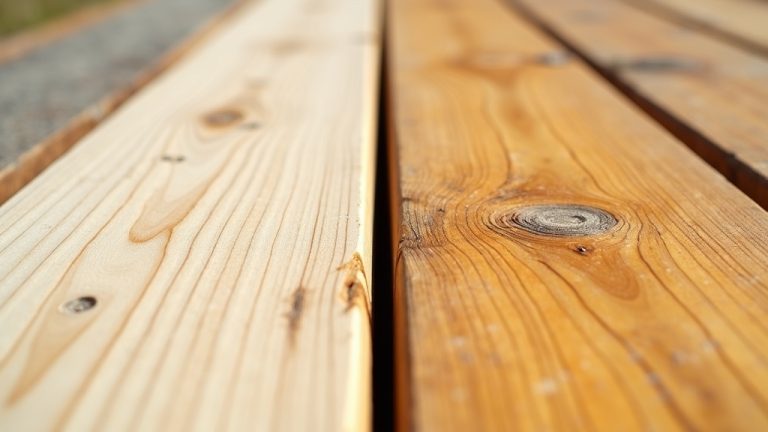Edge vs End Grain Cutting Board: Which Lasts Longer?
If you want a cutting board that protects your knives and lasts longer, choose end grain—it absorbs impact and self-heals cuts, preserving sharpness but costs more and needs regular oiling.
Edge grain boards are more affordable and easier to maintain, ideal for casual use but dull knives faster and show more wear.
Both require proper cleaning to stay hygienic. Understanding these differences helps you pick the board that best fits your kitchen needs and style.
- Solid Wooden Cutting Board: Elevate your food prep with a John Boos R-Board series wood cutting…
- Crafted for Your Home: This thick wooden charcuterie board boasts reversible sides, recessed finger…
- Made for Life: Available in 3 different sizes for your serving and charcuterie-board needs, this…
- PREMIUM END GRAIN ACACIA WOOD CUTTING BOARD known for its rich colors with beautiful contrasting…
- MULTI-FUNCTIONAL BOARD serves as a prep station cutting and serving board for vegetables meat cheese…
- DURABLE END GRAIN WOOD CONSTRUCTION minimizes wear and tear on both cutlery and board for long…
Key Takeaways
- End grain boards have fibers perpendicular to the surface, offering better durability and self-healing properties compared to edge grain boards with parallel fibers.
- Edge grain boards are more affordable and have a sleek, linear appearance but show knife marks and wear faster than end grain boards.
- End grain cutting boards preserve knife sharpness longer by cushioning blades and reducing micro-chipping, unlike edge grain boards that dull knives quicker.
- End grain boards require more maintenance, including regular oiling and careful cleaning, but resist warping and bacterial contamination better than edge grain boards.
- Choosing between edge and end grain depends on budget, usage intensity, knife care priority, and willingness to maintain the board properly.
Quick Comparison of Edge and End Grain Cutting Boards
| Feature | Edge Grain Cutting Board | End Grain Cutting Board |
|---|---|---|
| Fiber Orientation | Fibers run parallel to surface | Fibers stand vertical (end facing up) |
| Knife Friendliness | Causes more blade wear; dulls knives faster | Gentle on knives, preserves edges |
| Durability | Strong but shows visible cut marks | Self-healing surface, longer lifespan |
| Maintenance | Lower upkeep; less frequent oiling | Requires regular oiling and care |
| Appearance | Linear, striped grain pattern | Checkerboard or mosaic block design |
| Warping Resistance | Can warp slightly over time | Thickness offers stability but sensitive to moisture |
| Hygiene | Knife scars can trap bacteria | Self-healing reduces deep cuts, more resistant to bacteria |
| Weight & Build | Generally lighter and thinner | Often thicker, heavier, more solid |
Construction and Fiber Orientation Differences
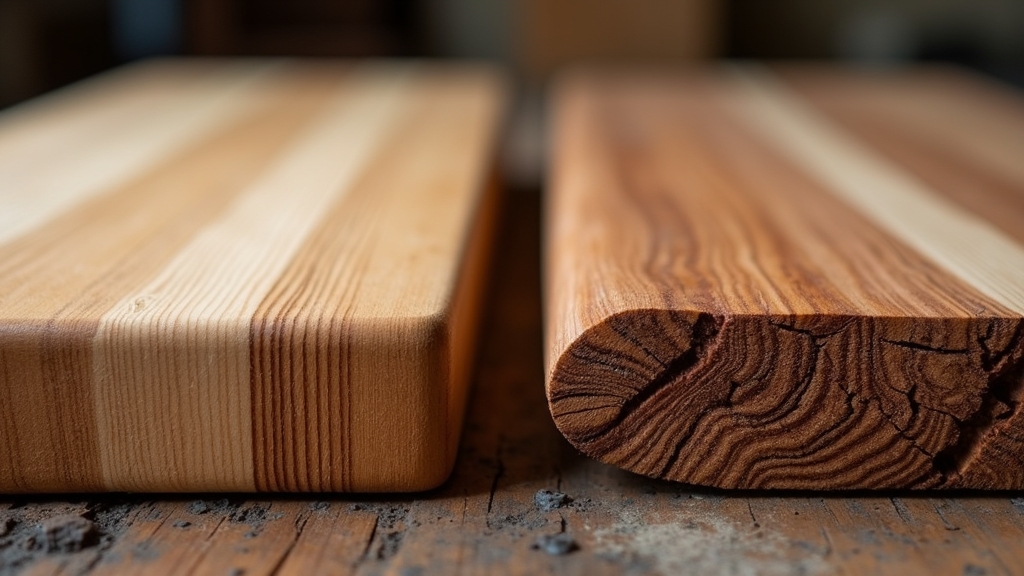
Although both edge grain and end grain cutting boards serve the same purpose, they differ fundamentally in how the wood fibers are oriented and assembled.
End grain boards feature wood fibers oriented perpendicular to the cutting surface, with blocks glued so the fiber ends face upward, creating a checkerboard pattern. This orientation allows knife blades to cut between fibers, reducing wear. This also makes end grain boards the most knife-friendly option, preserving blade sharpness over time.
End grain boards showcase fibers upright, letting knives cut between them to minimize blade wear.
End grain boards, however, require precise block orientation and alternating grain directions to minimize warping.
Edge grain boards, on the other hand, align wood fibers parallel to the surface by gluing long strips side by side, producing a linear grain pattern. This means knives cut directly along the fibers, increasing blade wear. Edge grain boards flip strips alternately during glue-up for stability.
Durability and Lifespan Comparison
Understanding the construction and fiber orientation differences between edge grain and end grain cutting boards sets the stage for evaluating their durability and lifespan.
End grain boards have fibers oriented perpendicularly, allowing them to absorb cutting impacts better. This design enables the board to self-heal, which extends its lifespan. The cutting surface is made from the log’s end pieces, which contributes to their unique durability.
Edge grain boards are durable but tend to show more visible knife marks. They’re also slightly prone to warping over time.
Here’s what you need to know:
- End grain boards resist warping and maintain structural integrity longer.
- Edge grain boards require less frequent maintenance but can scar more easily.
- Both need regular oiling, though end grain boards demand more upkeep.
- Gouges on edge grain boards can harbor bacteria if neglected.
- Proper sanding and oiling restore both, but end grain lasts noticeably longer.
Impact on Knife Sharpness and Maintenance
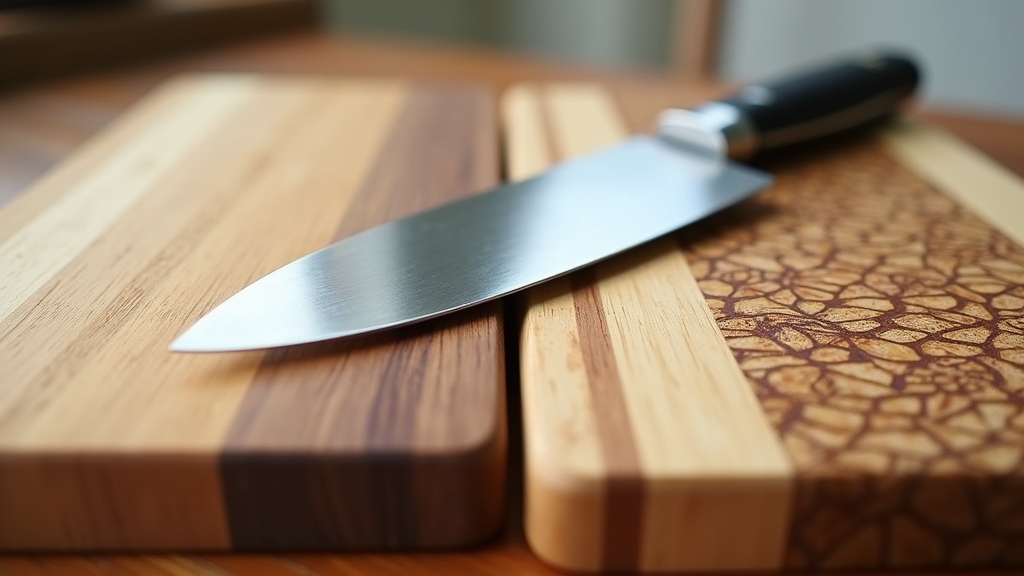
You’ll find that end grain boards preserve your knife’s edge better because their fibers absorb cuts instead of dulling the blade. This is due to the wood fibers standing vertically, which allow knife blades to slide between them, reducing damage to both the blade and the board.
However, they demand more frequent maintenance like regular oiling and careful cleaning to stay in top shape. Edge grain boards require less upkeep but cause faster blade wear due to their fiber orientation and surface impact.
Knife Edge Durability
When you use an end grain cutting board, your knife stays sharper longer because the blade slides between the wood fibers instead of cutting across them. This vertical fiber orientation cushions the blade, reducing wear and dulling.
Additionally, applying lubricant on bladesaw blade reduces friction and heat buildup, which similarly helps maintain blade sharpness.
End grain’s self-healing surface closes up after cuts, preserving both your knife edges and the board. These boards are often thicker and more durable for heavy use, making them ideal for frequent chopping tasks that demand longevity and resilience.
Key benefits include:
- Blade slides between fibers, minimizing edge damage
- Self-healing fibers reduce cumulative wear
- Softer surface lessens micro-chipping risk
- Fewer deep grooves maintain smooth cutting area
- Extended intervals between sharpenings
In contrast, edge grain boards cause faster dulling as knives cut across harder, horizontal fibers. This increases friction and requires more frequent blade maintenance, as they provide a stable surface but are less forgiving on blades.
Maintenance Requirements Comparison
While end grain boards preserve your knife’s edge longer due to their fiber orientation, they demand more attentive upkeep to maintain that benefit. You’ll need to oil them regularly to keep fibers moisturized and prevent cracking, especially in dry environments.
It is also important to avoid soaking or exposing the board to water, as water damage can warp or crack the wood. Using a carbide-tipped blade can help maintain precision when working with wooden materials like cutting boards.
Frequent cleaning right after use is vital to avoid moisture damage and bacterial buildup. Scrubbing with coarse salt occasionally helps remove deep debris. End grain boards also require periodic sanding to smooth gouges and restore the surface.
In contrast, edge grain boards need less frequent oiling and tolerate simpler cleaning routines, drying faster with lower risk of warping.
However, both types must be dried carefully and stored properly. Committing to these maintenance routines guarantees your cutting board stays functional and preserves your knife’s sharpness effectively.
Surface Impact on Blades
Although both edge grain and end grain cutting boards serve the same purpose, their wood fiber orientations considerably affect your knife’s sharpness and maintenance needs.
End grain boards feature vertical fibers that let your knife slip between them, preserving sharpness longer and minimizing blade trauma. They are often made from woods like maple, with walnut accents, which add to their durability and visual appeal due to their multiple colors or strips. This fiber orientation also offers superior blade stability during cutting, reducing deflection and wear.
Edge grain boards, with horizontal fibers, cause more wear by cutting across fibers, leading to quicker dulling and surface damage. End grain surfaces self-heal, reducing grooves and blade wear. In contrast, edge grain boards develop permanent scars, increasing blade nicks.
The vertical fibers in end grain boards cushion impact, lessening blade edge deformation. Edge grain boards wear unevenly, which can challenge blade control. Additionally, end grain boards distribute force evenly, extending blade life.
Visual Characteristics and Aesthetic Appeal
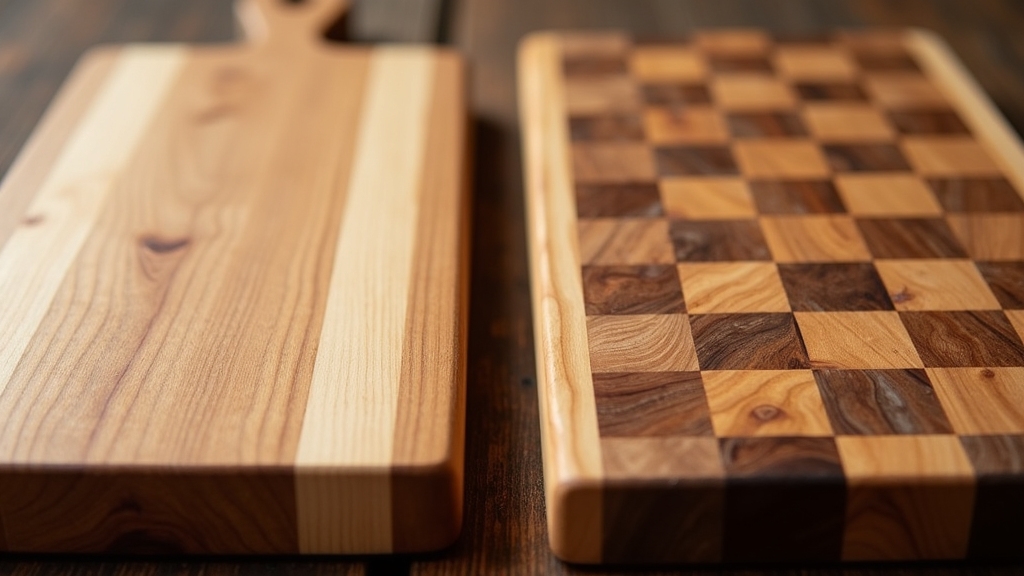
Because grain orientation directly influences a cutting board’s surface pattern, you’ll notice edge grain boards offer sleek, linear stripes formed by wood strips glued side by side. In contrast, end grain boards reveal intricate checkerboard or block designs created by the exposed fiber ends. Edge grain boards typically feature thicker grain layers that provide durability and stability.
Edge grain boards present a modern, minimalistic aesthetic with consistent grain patterns and warm tones that complement many kitchen decors. Their smooth surface lends a clean, polished look, highlighting natural wood streaks and subtle color variations. Edge grain boards have a sleek, striped look that highlights the wood’s natural beauty.
End grain boards showcase complex, mosaic-like patterns combining multiple wood species. These create striking multi-tone designs that change with the viewing angle. This artisanal quality makes end grain boards stand out as premium, tactile pieces. They often become conversation starters due to their distinctive, textured surfaces.
Sanitation and Cleaning Practices
You need to understand how bacterial resistance varies between edge and end grain boards to guarantee the best option for hygiene. Each board type requires specific cleaning techniques to prevent contamination effectively, as improper methods can increase cutting accuracy risks.
Maintaining your board with proper oiling and gentle cleaning ensures long-term sanitation and durability. It is important to scrape off food debris and scrub with warm water and detergent after use to keep the board clean and safe.
Bacterial Resistance Differences
When choosing between edge and end grain cutting boards, you’ll find that their wood fiber orientation directly impacts how bacteria resist sanitation and cleaning efforts. This is similar to how a belt drive system in table saws uses a different power transfer method affecting performance and maintenance.
End grain boards expose wood fibers vertically, reducing deep cuts and limiting bacterial lodging. In contrast, edge grain boards’ horizontal fibers suffer more gouging, creating crevices where bacteria can thrive.
Consider these key points:
- End grain boards’ self-healing fibers maintain smoother surfaces, lowering bacterial habitats.
- Edge grain boards develop more scars, increasing contamination risk.
- Wood’s natural tannins inhibit bacterial growth on both board types.
- Uncoated, oil-treated wood allows bacteria to sink and die below the surface.
- Different wood species vary in antibacterial effectiveness, influencing board choice.
- Coatings interfere with the wood’s natural ability to move bacteria, often increasing surface bacterial presence on cutting boards coatings impact.
Cleaning Techniques Comparison
Understanding bacterial resistance in edge and end grain cutting boards sets the stage for effective cleaning strategies tailored to each type.
You should always remove visible food debris first, using nylon brushes, sponges, or plastic scrapers—avoid steel brushes to prevent surface damage. Scrub end grain boards in circular motions to dislodge particles from their textured surface, while edge grain boards require thorough scrubbing suited to their smoother texture.
The choice of cleaning tools and techniques can affect the longevity of the board’s surface, similar to how tooth count affects blade performance in woodworking.
Use hot water and mild dish soap for washing, but never soak the boards to avoid warping. End grain boards are not fully waterproof, so prolonged exposure to water can cause warping and splitting.
For sanitation, apply diluted vinegar or hydrogen peroxide briefly, especially after contact with raw meats. Always dry your boards immediately and store them upright to maintain airflow, preventing moisture buildup that fosters bacterial growth and wood damage.
Maintenance for Hygiene
Although proper cleaning removes most surface contaminants, maintaining hygiene on edge and end grain cutting boards requires consistent sanitation and careful upkeep. You should focus on preventing bacterial growth by drying boards immediately and storing them upright to avoid moisture trapping.
Regularly apply food-safe mineral oil to all surfaces to keep the wood conditioned without over-oiling. It is important to cover all sides and underneath the board during oiling to ensure thorough protection. Using a motor with appropriate cooling mechanisms is essential when powering electric cleaning devices to avoid overheating. Use gentle cleaning tools and avoid harsh chemicals to preserve surface integrity and prevent bacterial niches.
For sanitizing, vinegar solutions and lemon with coarse salt work effectively without damaging the wood.
Key maintenance tips include:
- Dry boards thoroughly after washing and store on edges
- Oil all surfaces regularly with mineral or specialized oils
- Use soft scrapers or sponges, avoiding steel tools
- Sanitize frequently with vinegar-water or lemon-salt mixtures
- Separate boards for raw meat and ready-to-eat foods to prevent cross-contamination
Choosing the Right Board for Your Kitchen Needs
Since your kitchen needs vary, choosing between an edge grain and an end grain cutting board depends on balancing factors like durability, maintenance, cost, and how you use your board.
If you prioritize knife longevity and heavy chopping, an end grain board is ideal. Its self-healing surface is gentle on blades but demands frequent oiling and a higher investment.
Conversely, edge grain boards suit everyday use with less upkeep and a more affordable price. However, they dull knives faster and show more wear over time.
Consider your workload and care commitment carefully. Professionals or serious cooks benefit from end grain boards, while casual users often prefer edge grain for light prep and serving.
Visually, end grain offers a distinctive block pattern, while edge grain presents a classic linear look. Choose what complements your kitchen style and function best.
Frequently Asked Questions
Can End Grain Boards Be Used for Serving Food as Well as Cutting?
You can rely on end grain boards for both cutting and serving food. Imagine a board thick and heavy enough to hold a hearty charcuterie spread without sliding.
Their self-healing fibers close cuts, reducing bacteria buildup, and their natural antibacterial properties make them hygienic. Just clean thoroughly after raw meat use, oil regularly, and monitor for deep cuts.
This upkeep keeps your board safe, durable, and visually stunning for any meal presentation.
Are Edge Grain Boards Suitable for Outdoor or Picnic Use?
Edge grain boards aren’t ideal for outdoor or picnic use because they absorb moisture easily, leading to warping and cracks. You’ll need to dry and oil them regularly to prevent damage and mold growth.
If you do use one outdoors, avoid exposure to rain or humidity and handle it carefully.
For durability and hygiene, consider plastic or composite boards instead, as they withstand outdoor conditions much better.
How Do Humidity and Climate Affect Each Board Type Over Time?
Humidity and climate are the invisible sculptors shaping your board over time. End grain boards absorb moisture quickly through open pores, causing them to swell, warp, or crack if not oiled regularly.
Edge grain boards swell less but still expand and contract with humidity shifts, risking gaps or warping. To protect your board, oil and wax it often, keep it dry, and avoid extreme temperature or moisture exposure.
Can These Boards Be Safely Used With All Types of Knives?
Yes, you can safely use both end grain and edge grain cutting boards with all types of knives. End grain boards are especially gentle on blades, preserving sharpness for high-end or delicate knives.
Edge grain boards also work well but may dull fine edges a bit faster. To keep your knives safe and sharp, maintain your boards properly by cleaning and oiling them regularly, regardless of the grain orientation you choose.
Are There Eco-Friendly or Sustainable Wood Options for These Boards?
You’ll find eco-friendly wood options so sustainable, they practically grow overnight! Bamboo is a top choice—rapidly renewable and USDA Biobased certified.
FSC-certified hardwoods like maple, teak, walnut, and cherry also offer durability and responsible sourcing. Look for boards finished with food-safe oils or beeswax, avoiding petroleum-based treatments.
Brands like Bambu and Teakhaus exemplify sustainable practices, so you can confidently choose cutting boards that protect your knives and the planet.
Find the Cutting Board That Fits Your Style
Choosing between edge and end grain cutting boards is like picking the right tool from a well-stocked toolbox—each serves a distinct purpose. Edge grain boards offer affordability and firmness, while end grain boards provide superior durability and knife-friendliness.
By understanding their construction, maintenance, and cost differences, you can select the perfect board that fits your kitchen’s demands, ensuring both longevity and ideal food preparation every time.
- EDGE GRAIN CUTTING BOARDS: THE CLASSIC CHOICE — Built for daily use, this edge grain wood cutting…
- PREMIUM TEAK: EXCEPTIONAL DURABILITY & WATER RESISTANCE — Treasured for its rich, golden-brown…
- MESS-FREE COUNTERS WITH DEEP JUICE GROOVE — Slice the juiciest meats or ripe fruit without the…
- END GRAIN BOARDS PROTECT KNIVES & SELF HEAL — End grain cutting boards are renowned for extreme…
- ELEGANT, HYGIENIC, & DURABLE AMERICAN BLACK WALNUT — Elevate your kitchen with the luxurious tones…
- STABLE & ORGANIZED PREP W/ NON-SLIP FEET & SORTING WELLS — The removable feet on this non slip…
Last update on 2025-12-31 / Affiliate links / Images from Amazon Product Advertising API

